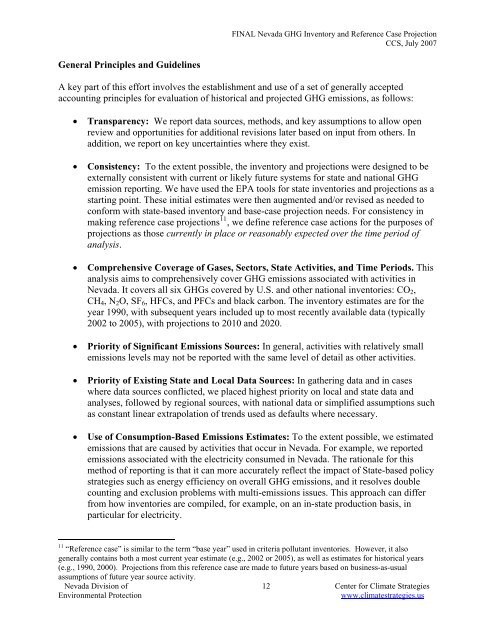Nevada Greenhouse Gas Inventory and Reference Case Projections
Nevada Greenhouse Gas Inventory and Reference Case Projections
Nevada Greenhouse Gas Inventory and Reference Case Projections
You also want an ePaper? Increase the reach of your titles
YUMPU automatically turns print PDFs into web optimized ePapers that Google loves.
FINAL <strong>Nevada</strong> GHG <strong>Inventory</strong> <strong>and</strong> <strong>Reference</strong> <strong>Case</strong> Projection<br />
CCS, July 2007<br />
General Principles <strong>and</strong> Guidelines<br />
A key part of this effort involves the establishment <strong>and</strong> use of a set of generally accepted<br />
accounting principles for evaluation of historical <strong>and</strong> projected GHG emissions, as follows:<br />
• Transparency: We report data sources, methods, <strong>and</strong> key assumptions to allow open<br />
review <strong>and</strong> opportunities for additional revisions later based on input from others. In<br />
addition, we report on key uncertainties where they exist.<br />
• Consistency: To the extent possible, the inventory <strong>and</strong> projections were designed to be<br />
externally consistent with current or likely future systems for state <strong>and</strong> national GHG<br />
emission reporting. We have used the EPA tools for state inventories <strong>and</strong> projections as a<br />
starting point. These initial estimates were then augmented <strong>and</strong>/or revised as needed to<br />
conform with state-based inventory <strong>and</strong> base-case projection needs. For consistency in<br />
making reference case projections 11 , we define reference case actions for the purposes of<br />
projections as those currently in place or reasonably expected over the time period of<br />
analysis.<br />
• Comprehensive Coverage of <strong>Gas</strong>es, Sectors, State Activities, <strong>and</strong> Time Periods. This<br />
analysis aims to comprehensively cover GHG emissions associated with activities in<br />
<strong>Nevada</strong>. It covers all six GHGs covered by U.S. <strong>and</strong> other national inventories: CO 2 ,<br />
CH 4 , N 2 O, SF 6 , HFCs, <strong>and</strong> PFCs <strong>and</strong> black carbon. The inventory estimates are for the<br />
year 1990, with subsequent years included up to most recently available data (typically<br />
2002 to 2005), with projections to 2010 <strong>and</strong> 2020.<br />
• Priority of Significant Emissions Sources: In general, activities with relatively small<br />
emissions levels may not be reported with the same level of detail as other activities.<br />
• Priority of Existing State <strong>and</strong> Local Data Sources: In gathering data <strong>and</strong> in cases<br />
where data sources conflicted, we placed highest priority on local <strong>and</strong> state data <strong>and</strong><br />
analyses, followed by regional sources, with national data or simplified assumptions such<br />
as constant linear extrapolation of trends used as defaults where necessary.<br />
• Use of Consumption-Based Emissions Estimates: To the extent possible, we estimated<br />
emissions that are caused by activities that occur in <strong>Nevada</strong>. For example, we reported<br />
emissions associated with the electricity consumed in <strong>Nevada</strong>. The rationale for this<br />
method of reporting is that it can more accurately reflect the impact of State-based policy<br />
strategies such as energy efficiency on overall GHG emissions, <strong>and</strong> it resolves double<br />
counting <strong>and</strong> exclusion problems with multi-emissions issues. This approach can differ<br />
from how inventories are compiled, for example, on an in-state production basis, in<br />
particular for electricity.<br />
11 “<strong>Reference</strong> case” is similar to the term “base year” used in criteria pollutant inventories. However, it also<br />
generally contains both a most current year estimate (e.g., 2002 or 2005), as well as estimates for historical years<br />
(e.g., 1990, 2000). <strong>Projections</strong> from this reference case are made to future years based on business-as-usual<br />
assumptions of future year source activity.<br />
<strong>Nevada</strong> Division of 12 Center for Climate Strategies<br />
Environmental Protection<br />
www.climatestrategies.us
















